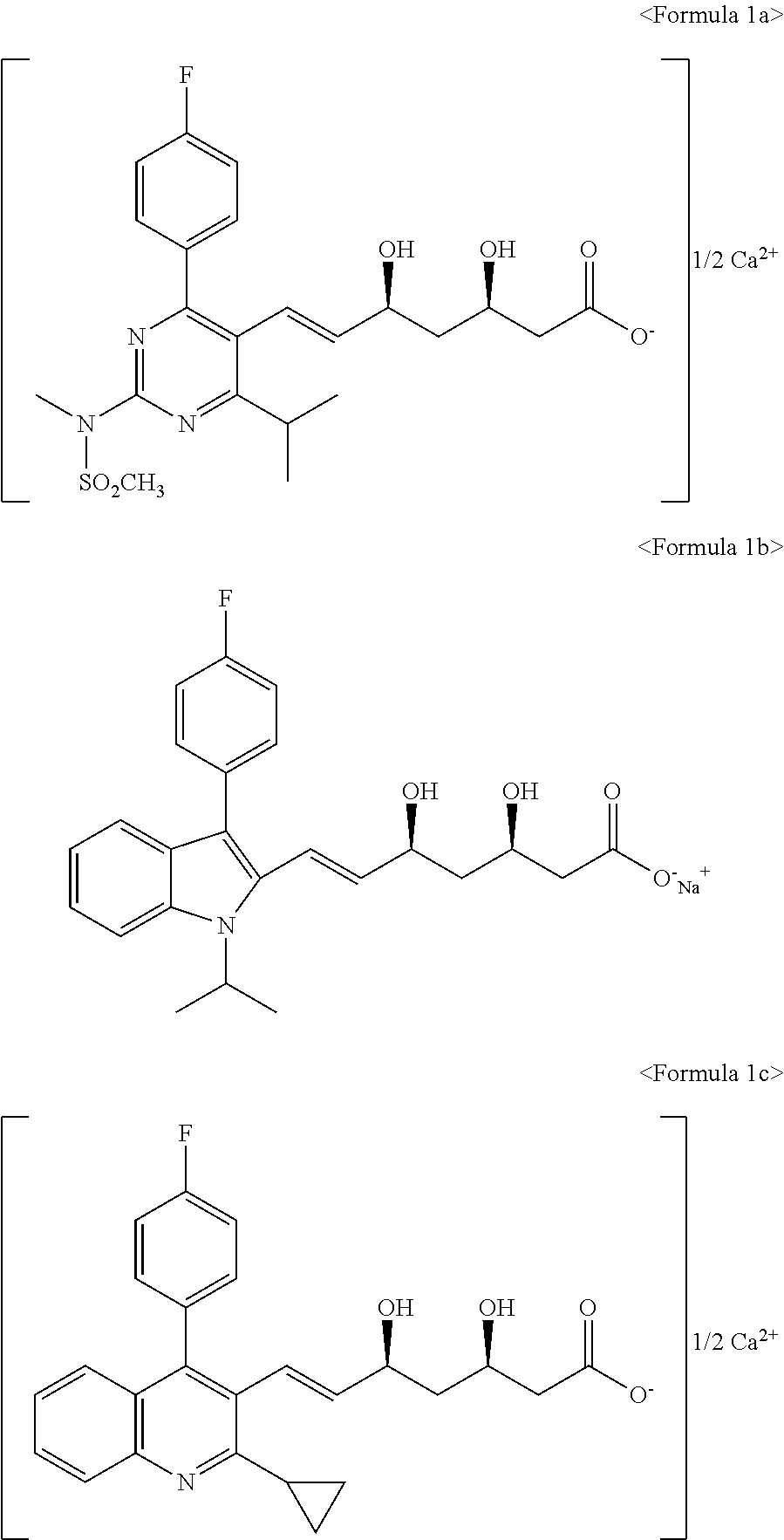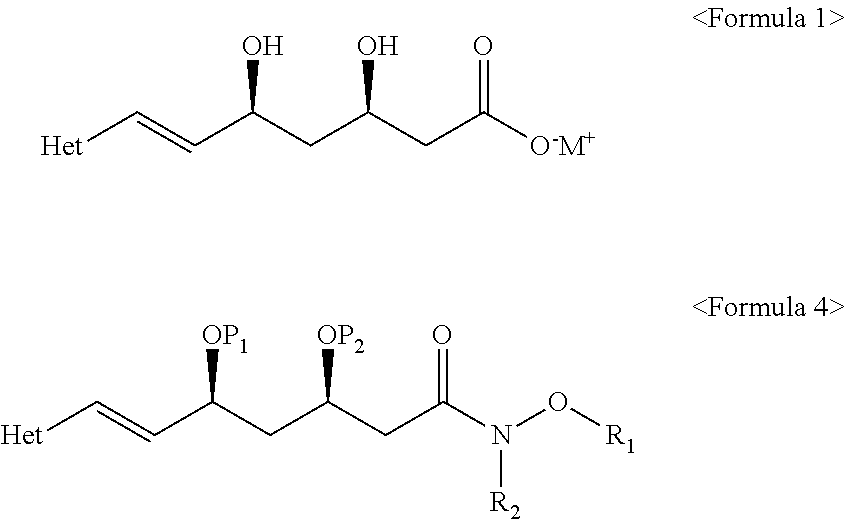Process for the preparation of HMG-COA reductase inhibitors and intermediates thereof
a reductase inhibitor and process technology, applied in the field of process for the preparation of hmgcoa reductase inhibitors and intermediates thereof, can solve the problems of difficult application of the process to industrial mass production, process not suitable for industrial mass production, and inability to meet the requirements of industrial mass production, etc., to achieve easy isolation, reduce reaction steps, and high steroselectivity
- Summary
- Abstract
- Description
- Claims
- Application Information
AI Technical Summary
Benefits of technology
Problems solved by technology
Method used
Image
Examples
preparation 1
N-[4-(4-fluorophenyl)-5-hydroxymethyl-6-isopropyl-pyrimidin-2-yl]-N-methyl-methanesulfonamide
[0109]Ethyl 2-(N-methyl-N-methanesulfonylamino)-4-(4-fluorophenyl)-6-isopropyl-pyrimidin-5-carboxylic acid (100.0 g) and toluene (500.0 mL) were added to a reactor under nitrogen atmosphere. The reaction mixture was cooled to −78° C. A solution of diisobutylaluminium hydride in toluene (1.5 M, 200.0 mL) was slowly added thereto. The temperature of the reaction mixture was adjusted to 0° C. The reaction mixture was stirred for over 1 hour and then water (500.0 mL) was added thereto. The separated organic layer was sequentially washed with 1N hydrochloric acid solution (500.0 mL), 5% sodium bicarbonate solution (500.0 mL), and then water (500.0 mL), and then concentrated under reduced pressure. n-Hexane (300.0 mL) was added to the resulting residue under stirring. The resulting suspension was filtered under reduced pressure, and then dried to obtain N-[4-(4-fluorophenyl)-5-hydroxymethyl-6-isop...
preparation 2
N-[5-chloromethyl-4-(4-fluorophenyl)-6-isopropyl-pyrimidin-2-yl]-N-methyl-methanesulfonamide
[0111]N-[4-(4-fluorophenyl)-5-hydroxymethyl-6-isopropyl-pyrimidin-2-yl]-N-methyl-methanesulfonamide (50.0 g), dichloromethane (250.0 mL), and triethylamine (47.3 mL) were added to a reactor and then the reaction mixture was cooled to 0˜5° C. Methanesulfonyl chloride (13.2 mL) was slowly added to the reaction mixture, which was then stirred at 20˜25° C. for 5 hours. Water (100.0 mL) was added to the reaction mixture. The separated organic layer was sequentially washed with 0.5N hydrochloric acid solution (100.0 mL) and then water (100.0 mL). The organic layer was concentrated under reduced pressure to remove the solvent. n-Hexane (150.0 mL) was added to the resulting residue under stirring. The resulting suspension was filtered under reduced pressure. The resulting white solid was dried to obtain N-[5-chloromethyl-4-(4-fluorophenyl)-6-isopropyl-pyrimidin-2-yl]-N-methyl-methanesulfonamide (45.5...
preparation 3
N-[5-bromomethyl-4-(4-fluorophenyl)-6-isopropyl-pyrimidin-2-yl]-N-methyl-methanesulfonamide
[0113]N-[4-(4-fluorophenyl)-5-hydroxymethyl-6-isopropyl-pyrimidin-2-yl]-N-methyl-methanesulfonamide (50.0 g) and 48% hydrogen bromide (130.0 mL) were added to a reactor. The reaction mixture was stirred at 80° C. for 15 hours. The reaction was monitored with thin layer chromatography (ethyl acetate / n-hexane=1:2). The reaction mixture was cooled to 20˜25° C., stirred for over 1 hour, and then filtered under reduced pressure. The resulting white solid was washed with water (500.0 mL) and then dried under reduced pressure to obtain N-[5-bromomethyl-4-(4-fluorophenyl)-6-isopropyl-pyrimidin-2-yl]-N-methyl-methanesulfonamide as a white solid (55.3 g, yield 94%).
[0114]1H-NMR, 400 MHz, CDCl3, ppm: 1.35 (d, 6H), 3.48 (m, 1H), 3.49 (s, 3H), 3.56 (s, 3H), 4.48 (q, 2H), 7.23 (t, 2H), 7.81 (q, 2H)
PUM
| Property | Measurement | Unit |
|---|---|---|
| temperature | aaaaa | aaaaa |
| temperature | aaaaa | aaaaa |
| temperature | aaaaa | aaaaa |
Abstract
Description
Claims
Application Information
 Login to View More
Login to View More - R&D
- Intellectual Property
- Life Sciences
- Materials
- Tech Scout
- Unparalleled Data Quality
- Higher Quality Content
- 60% Fewer Hallucinations
Browse by: Latest US Patents, China's latest patents, Technical Efficacy Thesaurus, Application Domain, Technology Topic, Popular Technical Reports.
© 2025 PatSnap. All rights reserved.Legal|Privacy policy|Modern Slavery Act Transparency Statement|Sitemap|About US| Contact US: help@patsnap.com



